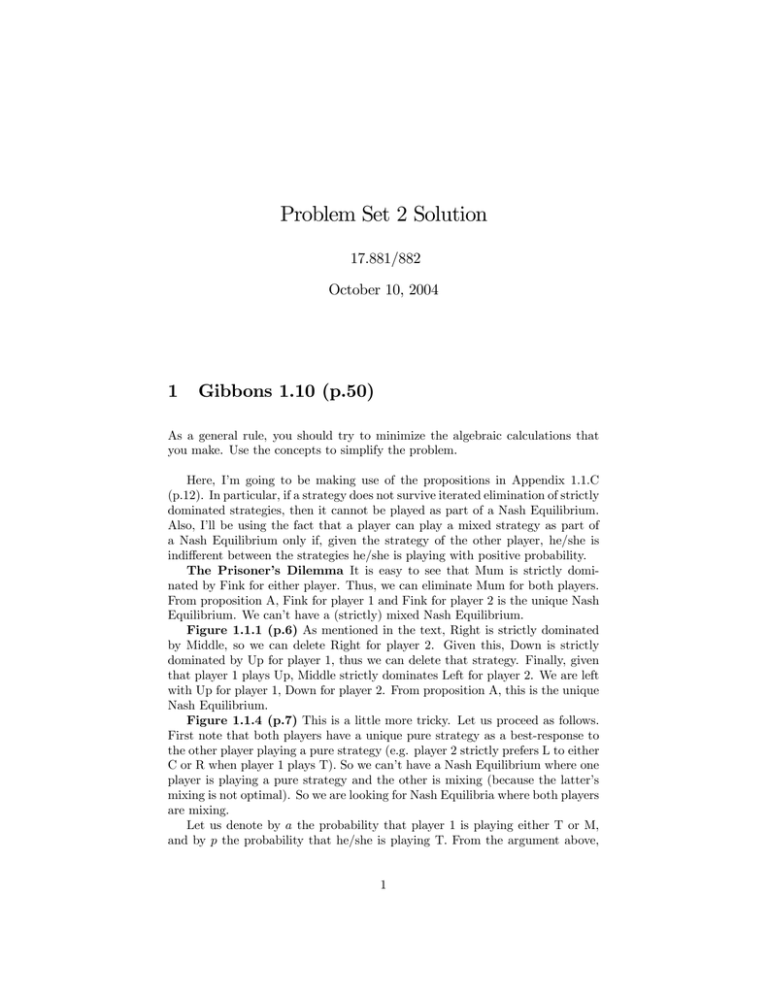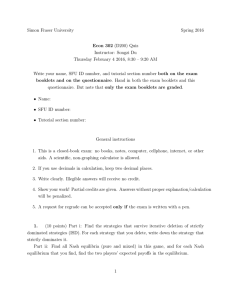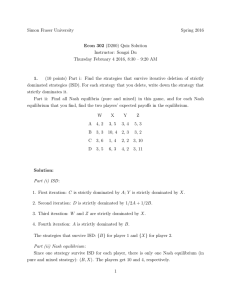Problem Set 2 Solution 1 Gibbons 1.10 (p.50)
advertisement

Problem Set 2 Solution 17.881/882 October 10, 2004 1 Gibbons 1.10 (p.50) As a general rule, you should try to minimize the algebraic calculations that you make. Use the concepts to simplify the problem. Here, I’m going to be making use of the propositions in Appendix 1.1.C (p.12). In particular, if a strategy does not survive iterated elimination of strictly dominated strategies, then it cannot be played as part of a Nash Equilibrium. Also, I’ll be using the fact that a player can play a mixed strategy as part of a Nash Equilibrium only if, given the strategy of the other player, he/she is indifferent between the strategies he/she is playing with positive probability. The Prisoner’s Dilemma It is easy to see that Mum is strictly dominated by Fink for either player. Thus, we can eliminate Mum for both players. From proposition A, Fink for player 1 and Fink for player 2 is the unique Nash Equilibrium. We can’t have a (strictly) mixed Nash Equilibrium. Figure 1.1.1 (p.6) As mentioned in the text, Right is strictly dominated by Middle, so we can delete Right for player 2. Given this, Down is strictly dominated by Up for player 1, thus we can delete that strategy. Finally, given that player 1 plays Up, Middle strictly dominates Left for player 2. We are left with Up for player 1, Down for player 2. From proposition A, this is the unique Nash Equilibrium. Figure 1.1.4 (p.7) This is a little more tricky. Let us proceed as follows. First note that both players have a unique pure strategy as a best-response to the other player playing a pure strategy (e.g. player 2 strictly prefers L to either C or R when player 1 plays T). So we can’t have a Nash Equilibrium where one player is playing a pure strategy and the other is mixing (because the latter’s mixing is not optimal). So we are looking for Nash Equilibria where both players are mixing. Let us denote by a the probability that player 1 is playing either T or M, and by p the probability that he/she is playing T. From the argument above, 1 we know that a (0, 1], and, of course, p [0, a]. Can we have a Nash Equilibrium where 2 is mixing between L and C? 2 would do so if he/she were indifferent between both strategies AND if either of them is (weakly) better than T given 1’s mixing. Now, we have Eu2 (L) = 4p + 5(1 − a) Eu2 (C) = 4(a − p) + 5(1 − a) Eu2 (R) = 3a + 6(1 − a) 2 is indifferent between L and C if and only if Eu2 (L) = Eu2 (C), ie p = a/2 But then Eu2 (L) = Eu2 (C) = 2a + 5(1 − a) < 3a + 6(1 − a) = Eu2 (R) so player 2 would actually strictly prefer playing R than either L or C given 1’s mixing. Thus, we can’t have a Nash Equilibrium where 2 is mixing between either L and C only or between L,C, and R. So we only need to eliminate the cases where 2 is mixing between L and R or between C and R. Let us consider the first case. Write that 2 is playing L with probability q and R with probability 1 − q, with q (0, 1). Then Eu1 (T ) = 5(1 − q) < Eu1 (M ) = 4q + 5(1 − q) which means that 1 will not be playing M, ie p = 0, which in turn implies that Eu2 (L) = 5(1 − a) < 3a + 6(1 − a) = Eu2 (R), so q = 0, a contradiction. The second case can be eliminated in a similar way. Thus we found that under no circumstance can a mixing by 2 be part of a Nash Equilibrium, which completes the result.









